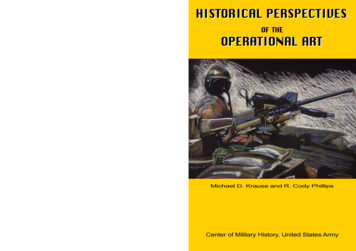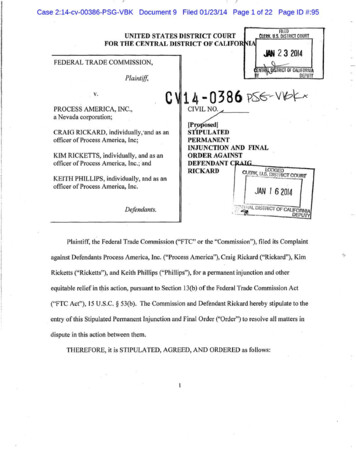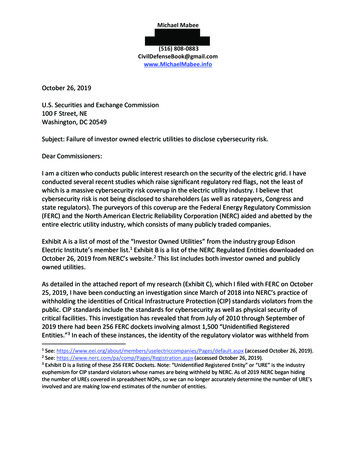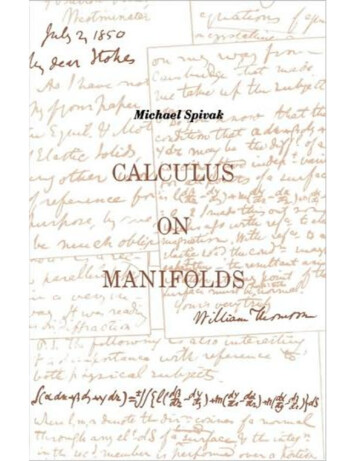
Transcription
Michael D. Krause andR. Cody PhillipsHistorical Perspectivesof theOperational ArtHistorical Perspectivesof the Operational ArtCenter of Military HistoryUnited States ArmyPIN: 081038–000Michael D. Krause and R. Cody PhillipsCenter of Military History, United States Army
PrefaceHistorical Perspectives of the Operational Art is a unique study inthe field of military history. Relying on the expertise of scholars andmilitary historians from the United States, Great Britain, and Germany, ithighlights some of the significant developments in the modern evolutionof the operational level of war. Our intention was not to include everymajor military power in recent history — and certainly not every conflict.Yet students of the operational art may want to look at past wars to seehow this added dimension of armed conflict might have surfaced orbeen applied. This study deals only with land warfare and is designedto show the doctrinal development and application of operational art inmodern history. Thus, while the British, Chinese, and Japanese clearlydemonstrated techniques associated with the operational art of war,their experiences tended to parallel practices already developed andimplemented elsewhere.Operational art has its origins in Western Europe. Beginning with theskillful adaptations of Napoleon Bonaparte, military commanders beganto recognize the middle ground that linked national strategic goals withtactical objectives on the battlefield. The Germans, following the exampleof Field Marshal Helmuth von Moltke, devised the initial conceptsabout the operational art of war, while French contemporaries wrestledwith devising a satisfactory doctrine of their own. The Russians andSoviets learned from their military brethren in Western Europe and alsodeveloped a vibrant doctrine that was masterfully implemented duringthe latter half of World War II. The United States, in contrast, entered thefield of study belatedly. Although there clearly were moments when theoperational art could be observed in selected campaigns, it is apparentthat the U.S. Army’s doctrinal development of this connection betweenstrategy and tactics progressed in an irregular manner and reachedfruition only recently — most notably in Operations Desert Shield andDesert Storm.Strategy, operations, and tactics routinely affect the dimensions ofmilitary conflict, each in a different manner. For instance, the strategistaims at the enemy center of gravity, which often is the nation’s will tofight, or perhaps the key resources or the delicate bond that holds analliance together. The operational artist’s center of gravity is the massof the enemy’s military force and its ability to command and control itsforces. At the tactical level, the battlefield commander has a more limitedand proximate perspective and focuses on his immediate foe. Strategymay dictate whether or not to fight, but operations will determine
Historical Perspectivesof theOperational ArtMichael D. Krause andR. Cody PhillipsGeneral EditorsCenter of Military HistoryUnited States ArmyWashington, D.C., 2005
ForewordLibrary of Congress Cataloging-in-Publication DataHistorical perspectives of the operational art / Michael D. Krause and R. Cody Phillips,general editors.p. cm.Includes bibliographical references.1. Operational art (Military science)—History. I. Krause, Michael D. (MichaelDetlef), 1942– II. Phillips, R. Cody.U163.H57 2005355.4’09—dc222004057948CMH Pub 70–89–1As we begin a new millennium and witness the rapid and complexchanges happening around the world, the study of the operational art ofwar becomes even more critical. Today our Army is facing a multitude ofchallenges ranging from disaster relief and peacekeeping operations toopen hostilities and war. To keep pace with both those demands and thegrowth of new technologies, we are currently transforming our servicefrom a primarily heavy, forward-deployed force to a lighter, more agile,but also more deadly CONUS-based one. At the same time, the scopeof our operations and our strategy is becoming increasingly influencedby our participation in international coalitions and alliances. The timehonored focus of operational art on the planning and execution of militarycampaigns has thus become even more diverse and complex, placing greatdemands on the military professional. Although operational art must beadjusted to accommodate these changing circumstances, it should notbe done without some understanding — a frame of reference — of thehistory of the operational level of war so as to clarify the nature of theproblems we can expect in the future.Historical Perspectives of the Operational Art is an anthology ofessays by historians and scholars who trace the origin and developmentof the operational level of warfare, the critical link between strategy andtactics. Col. Michael D. Krause, former deputy commander of the U.S.Army Center of Military History, made the initial selections for thisanthology. As a student of the subject and instructor at the National WarCollege, Colonel Krause was well qualified for the task. This volume maybe regarded as a continuation of an earlier publication that he coedited ona similar subject, On Operational Art, which is a collection of pieces bysenior military commanders and theorists dealing with the contemporaryapplication of the operational art of war. For the soldier and student alike,Historical Perspectives of the Operational Art should stimulate thoughtand provide a deeper understanding of military history and its ability toshed light on the problems and challenges of the present.Washington, D.C.John S. Brown17 May 2005Brigadier General, USA (Ret.)Chief of Military Historyiii
ForewordLibrary of Congress Cataloging-in-Publication DataHistorical perspectives of the operational art / Michael D. Krause and R. Cody Phillips,general editors.p. cm.Includes bibliographical references.1. Operational art (Military science)—History. I. Krause, Michael D. (MichaelDetlef), 1942– II. Phillips, R. Cody.U163.H57 2005355.4’09—dc222004057948CMH Pub 70–89–1As we begin a new millennium and witness the rapid and complexchanges happening around the world, the study of the operational art ofwar becomes even more critical. Today our Army is facing a multitude ofchallenges ranging from disaster relief and peacekeeping operations toopen hostilities and war. To keep pace with both those demands and thegrowth of new technologies, we are currently transforming our servicefrom a primarily heavy, forward-deployed force to a lighter, more agile,but also more deadly CONUS-based one. At the same time, the scopeof our operations and our strategy is becoming increasingly influencedby our participation in international coalitions and alliances. The timehonored focus of operational art on the planning and execution of militarycampaigns has thus become even more diverse and complex, placing greatdemands on the military professional. Although operational art must beadjusted to accommodate these changing circumstances, it should notbe done without some understanding — a frame of reference — of thehistory of the operational level of war so as to clarify the nature of theproblems we can expect in the future.Historical Perspectives of the Operational Art is an anthology ofessays by historians and scholars who trace the origin and developmentof the operational level of warfare, the critical link between strategy andtactics. Col. Michael D. Krause, former deputy commander of the U.S.Army Center of Military History, made the initial selections for thisanthology. As a student of the subject and instructor at the National WarCollege, Colonel Krause was well qualified for the task. This volume maybe regarded as a continuation of an earlier publication that he coedited ona similar subject, On Operational Art, which is a collection of pieces bysenior military commanders and theorists dealing with the contemporaryapplication of the operational art of war. For the soldier and student alike,Historical Perspectives of the Operational Art should stimulate thoughtand provide a deeper understanding of military history and its ability toshed light on the problems and challenges of the present.Washington, D.C.John S. Brown17 May 2005Brigadier General, USA (Ret.)Chief of Military Historyiii
PrefaceHistorical Perspectives of the Operational Art is a unique study inthe field of military history. Relying on the expertise of scholars andmilitary historians from the United States, Great Britain, and Germany, ithighlights some of the significant developments in the modern evolutionof the operational level of war. Our intention was not to include everymajor military power in recent history — and certainly not every conflict.Yet students of the operational art may want to look at past wars to seehow this added dimension of armed conflict might have surfaced orbeen applied. This study deals only with land warfare and is designedto show the doctrinal development and application of operational art inmodern history. Thus, while the British, Chinese, and Japanese clearlydemonstrated techniques associated with the operational art of war,their experiences tended to parallel practices already developed andimplemented elsewhere.Operational art has its origins in Western Europe. Beginning with theskillful adaptations of Napoleon Bonaparte, military commanders beganto recognize the middle ground that linked national strategic goals withtactical objectives on the battlefield. The Germans, following the exampleof Field Marshal Helmuth von Moltke, devised the initial conceptsabout the operational art of war, while French contemporaries wrestledwith devising a satisfactory doctrine of their own. The Russians andSoviets learned from their military brethren in Western Europe and alsodeveloped a vibrant doctrine that was masterfully implemented duringthe latter half of World War II. The United States, in contrast, entered thefield of study belatedly. Although there clearly were moments when theoperational art could be observed in selected campaigns, it is apparentthat the U.S. Army’s doctrinal development of this connection betweenstrategy and tactics progressed in an irregular manner and reachedfruition only recently — most notably in Operations Desert Shield andDesert Storm.Strategy, operations, and tactics routinely affect the dimensions ofmilitary conflict, each in a different manner. For instance, the strategistaims at the enemy center of gravity, which often is the nation’s will tofight, or perhaps the key resources or the delicate bond that holds analliance together. The operational artist’s center of gravity is the massof the enemy’s military force and its ability to command and control itsforces. At the tactical level, the battlefield commander has a more limitedand proximate perspective and focuses on his immediate foe. Strategymay dictate whether or not to fight, but operations will determine
PrefaceHistorical Perspectives of the Operational Art is a unique study inthe field of military history. Relying on the expertise of scholars andmilitary historians from the United States, Great Britain, and Germany, ithighlights some of the significant developments in the modern evolutionof the operational level of war. Our intention was not to include everymajor military power in recent history — and certainly not every conflict.Yet students of the operational art may want to look at past wars to seehow this added dimension of armed conflict might have surfaced orbeen applied. This study deals only with land warfare and is designedto show the doctrinal development and application of operational art inmodern history. Thus, while the British, Chinese, and Japanese clearlydemonstrated techniques associated with the operational art of war,their experiences tended to parallel practices already developed andimplemented elsewhere.Operational art has its origins in Western Europe. Beginning with theskillful adaptations of Napoleon Bonaparte, military commanders beganto recognize the middle ground that linked national strategic goals withtactical objectives on the battlefield. The Germans, following the exampleof Field Marshal Helmuth von Moltke, devised the initial conceptsabout the operational art of war, while French contemporaries wrestledwith devising a satisfactory doctrine of their own. The Russians andSoviets learned from their military brethren in Western Europe and alsodeveloped a vibrant doctrine that was masterfully implemented duringthe latter half of World War II. The United States, in contrast, entered thefield of study belatedly. Although there clearly were moments when theoperational art could be observed in selected campaigns, it is apparentthat the U.S. Army’s doctrinal development of this connection betweenstrategy and tactics progressed in an irregular manner and reachedfruition only recently — most notably in Operations Desert Shield andDesert Storm.Strategy, operations, and tactics routinely affect the dimensions ofmilitary conflict, each in a different manner. For instance, the strategistaims at the enemy center of gravity, which often is the nation’s will tofight, or perhaps the key resources or the delicate bond that holds analliance together. The operational artist’s center of gravity is the massof the enemy’s military force and its ability to command and control itsforces. At the tactical level, the battlefield commander has a more limitedand proximate perspective and focuses on his immediate foe. Strategymay dictate whether or not to fight, but operations will determine
where and when to fight and tactics how to conduct the fight. In turn,tacticians employ fire and maneuver to achieve a limited objective, whileoperational commanders use fire and maneuver on a larger scale to createan imbalance against the enemy and set the tempo of a campaign. For atactician, intelligence is concerned with capabilities; but at the operationallevel, intelligence is focused on enemy intentions. A tactical commanderwill use deception to hide his forces; an operational commander will usedeception to mask his intentions.The use of reserves is critical to the operational artist. Yet these arenot reserves that might represent an inactive force waiting to be put intoaction, which is customarily how reserves are seen at the tactical level.Rather, reserves at the operational level are thought of as the futureemployment of forces that may or may not already be engaged in thebattle or campaign. Logistics too is a factor in this discussion. At thestrategic level, force generation capability and logistics are applied inbroad terms and viewed as long-term reserves. At the operational level,the logistics capability is another form of reserve and an asset that affectsthe outcome of an armed conflict. At the tactical level, however, logisticsaffects only the battle in progress.From the strategic level, a commander looks toward the outcome ofcampaigns and battles as a means of achieving national policy objectives.This process requires a focus on a distant goal. The operational commanderoften looks to a closer goal, which would be achieved following a campaignor series of battles. Obviously, the tactical commander is focused on theoutcome of specific engagements or battles.Simply stated, the strategist identifies broad goals and generates thecapabilities to achieve those goals, while the operational commanderseeks a unity of effort over a specific period of time, and the tacticianinitiates immediate action on the field of battle. The operational art ofwar is thus different in sum and part. It is more than large-scale tactics,but it is not small-scale strategy either. It has both a tactical and astrategic dimension, because it must create a vision of unity of action onthe battlefield that ultimately achieves a strategic objective.For both the soldier and the student of military history, this anthologywill provide an orientation to significant battles and campaigns from thepast. Rather than view the sound generalship of Napoleon and the tacticaldisplacement of his divisions at Jena, the reader might also consider howthis battle and the entire campaign affected both the French and Prussianstrategies. Even the dramatic clash at Gettysburg becomes more thansimply Little Round Top, Cemetery Ridge, Culp’s Hill, and Pickett’sCharge, especially when given an operational perspective. HistoricalPerspectives of the Operational Art encourages students and soldiersalike to think beyond the battle that is before them. Isolated and takenout of context, tactical maneuvers can provide a surreal comprehensionof their importance and encourage a detachment from the larger strategy.The Allies were so focused on successful landings at Normandy, forexample, that they had invested little planning to breaking out from thebeachheads. And when that time came, despite the clear opportunity toinflict a crushing blow to the German Army, the Allies elected to squandertheir resources on more limited tactical objectives. Finally, particularlyfor soldiers, the enclosed essays might assist in understanding whatoperational art is and how it is applied in contemporary doctrine.A number of people contributed to the final compilation andpublication of this anthology — not the least were the individualcontributors whose works are in this text. We owe a debt of appreciationto the Center of Military History and its chief, Brig. Gen. John S. Brown,as well as its chief historian, Dr. Jeffrey J. Clarke, who helped revivethis project at a moment when it seemed certain to die stillborn. Fourindividuals in particular merit special recognition for lending theirtechnical expertise to this anthology and its subsequent publication:Ms. Beth MacKenzie, chief of the Center’s Graphics Branch, diligentlyguided the final manuscript through the publication process; Ms. DianeDonovan, a senior editor in the Editorial Branch, demonstrated patienceand literary skills that far exceeded our abilities to articulate; Ms. SusanCarroll compiled the index; and Ms. Linda Moten assisted in the finalreview and editing of individual essays. We edited individual contributionsto ensure a standardized format, while being careful not to mask or alterindividual writing styles, not to mention the views and conclusionspresented in each essay. Reprinted essays were rarely altered from theiroriginal versions, except for either space considerations or clarificationof technical matters. The views expressed in these selections are those ofthe individual authors and do not reflect the official policy or positions ofthe Departments of the Army and Defense or the U.S. government.viviiWashington, D.C.22 July 2004Michael D. KrauseR. Cody Phillips
where and when to fight and tactics how to conduct the fight. In turn,tacticians employ fire and maneuver to achieve a limited objective, whileoperational commanders use fire and maneuver on a larger scale to createan imbalance against the enemy and set the tempo of a campaign. For atactician, intelligence is concerned with capabilities; but at the operationallevel, intelligence is focused on enemy intentions. A tactical commanderwill use deception to hide his forces; an operational commander will usedeception to mask his intentions.The use of reserves is critical to the operational artist. Yet these arenot reserves that might represent an inactive force waiting to be put intoaction, which is customarily how reserves are seen at the tactical level.Rather, reserves at the operational level are thought of as the futureemployment of forces that may or may not already be engaged in thebattle or campaign. Logistics too is a factor in this discussion. At thestrategic level, force generation capability and logistics are applied inbroad terms and viewed as long-term reserves. At the operational level,the logistics capability is another form of reserve and an asset that affectsthe outcome of an armed conflict. At the tactical level, however, logisticsaffects only the battle in progress.From the strategic level, a commander looks toward the outcome ofcampaigns and battles as a means of achieving national policy objectives.This process requires a focus on a distant goal. The operational commanderoften looks to a closer goal, which would be achieved following a campaignor series of battles. Obviously, the tactical commander is focused on theoutcome of specific engagements or battles.Simply stated, the strategist identifies broad goals and generates thecapabilities to achieve those goals, while the operational commanderseeks a unity of effort over a specific period of time, and the tacticianinitiates immediate action on the field of battle. The operational art ofwar is thus different in sum and part. It is more than large-scale tactics,but it is not small-scale strategy either. It has both a tactical and astrategic dimension, because it must create a vision of unity of action onthe battlefield that ultimately achieves a strategic objective.For both the soldier and the student of military history, this anthologywill provide an orientation to significant battles and campaigns from thepast. Rather than view the sound generalship of Napoleon and the tacticaldisplacement of his divisions at Jena, the reader might also consider howthis battle and the entire campaign affected both the French and Prussianstrategies. Even the dramatic clash at Gettysburg becomes more thansimply Little Round Top, Cemetery Ridge, Culp’s Hill, and Pickett’sCharge, especially when given an operational perspective. HistoricalPerspectives of the Operational Art encourages students and soldiersalike to think beyond the battle that is before them. Isolated and takenout of context, tactical maneuvers can provide a surreal comprehensionof their importance and encourage a detachment from the larger strategy.The Allies were so focused on successful landings at Normandy, forexample, that they had invested little planning to breaking out from thebeachheads. And when that time came, despite the clear opportunity toinflict a crushing blow to the German Army, the Allies elected to squandertheir resources on more limited tactical objectives. Finally, particularlyfor soldiers, the enclosed essays might assist in understanding whatoperational art is and how it is applied in contemporary doctrine.A number of people contributed to the final compilation andpublication of this anthology — not the least were the individualcontributors whose works are in this text. We owe a debt of appreciationto the Center of Military History and its chief, Brig. Gen. John S. Brown,as well as its chief historian, Dr. Jeffrey J. Clarke, who helped revivethis project at a moment when it seemed certain to die stillborn. Fourindividuals in particular merit special recognition for lending theirtechnical expertise to this anthology and its subsequent publication:Ms. Beth MacKenzie, chief of the Center’s Graphics Branch, diligentlyguided the final manuscript through the publication process; Ms. DianeDonovan, a senior editor in the Editorial Branch, demonstrated patienceand literary skills that far exceeded our abilities to articulate; Ms. SusanCarroll compiled the index; and Ms. Linda Moten assisted in the finalreview and editing of individual essays. We edited individual contributionsto ensure a standardized format, while being careful not to mask or alterindividual writing styles, not to mention the views and conclusionspresented in each essay. Reprinted essays were rarely altered from theiroriginal versions, except for either space considerations or clarificationof technical matters. The views expressed in these selections are those ofthe individual authors and do not reflect the official policy or positions ofthe Departments of the Army and Defense or the U.S. government.viviiWashington, D.C.22 July 2004Michael D. KrauseR. Cody Phillips
ContentsPageOperational Art’s OriginsBruce W. Menning, Ph.D.3Part One: FranceIntroduction25Napoleon, Operational Art, and the Jena CampaignDavid G. Chandler, Ph.D.27French Operational Art: 1888–1940Col. Robert A. Doughty69Part Two: GermanyIntroduction111Moltke and the Origins of the Operational Level of WarCol. Michael D. Krause, U.S. Army, Retired113Operational Thought from Schlieffen to MansteinBrig. Gen. Günter R. Roth149Panzer Group Kleist and the Breakthrough in France, 1940Karl-Heinz Frieser, Ph.D.169Part Three: Russia and the Soviet UnionIntroduction185The Imperial Russian Legacy of Operational Art, 1878 –1914Bruce W. Menning, Ph.D.189The Origins of Soviet Operational Art, 1917–1936Jacob W. Kipp, Ph.D.213Soviet Operational Art Since 1936: The Triumph ofManeuver WarCol. David M. Glantz, U.S. Army, RetiredSoviet Operational Logistics, 1939 –1990Graham H. Turbiville, Jr., Ph.D.ix247293
ContentsPageOperational Art’s OriginsBruce W. Menning, Ph.D.3Part One: FranceIntroduction25Napoleon, Operational Art, and the Jena CampaignDavid G. Chandler, Ph.D.27French Operational Art: 1888–1940Col. Robert A. Doughty69Part Two: GermanyIntroduction111Moltke and the Origins of the Operational Level of WarCol. Michael D. Krause, U.S. Army, Retired113Operational Thought from Schlieffen to MansteinBrig. Gen. Günter R. Roth149Panzer Group Kleist and the Breakthrough in France, 1940Karl-Heinz Frieser, Ph.D.169Part Three: Russia and the Soviet UnionIntroduction185The Imperial Russian Legacy of Operational Art, 1878 –1914Bruce W. Menning, Ph.D.189The Origins of Soviet Operational Art, 1917–1936Jacob W. Kipp, Ph.D.213Soviet Operational Art Since 1936: The Triumph ofManeuver WarCol. David M. Glantz, U.S. Army, RetiredSoviet Operational Logistics, 1939 –1990Graham H. Turbiville, Jr., Ph.D.ix247293
Part Four: The United StatesPageIntroduction329The Origins of Operational ArtBrig. Gen. Harold W. Nelson, U.S. Army, Retired333Operational Art and the Gettysburg CampaignCol. Arthur V. Grant, U.S. Army, Retired349Normandy to Falaise: A Critique of Allied OperationalPlanning in 1944Russell F. Weigley, Ph.D.After Inch on: MacArthur’s 1950 Campaign in North KoreaCol. Stanlis David Milkowski, U.S. Army, Retired393415The Maturation of Operational Art: Operations Desert Shieldand Desert StormBrig. Gen. John S. Brown439Afterword483List of Contributors485Index489Page6. The Marne Campaign, August/September 19147. 1st Deployment Plan “Yellow”8. The Advance to Avesnes and Le Cateau, 17 May 19409. The Planned Pincer Movement by the Allies on the“Corridor of Arras,” 21 May 194010. Gettysburg Campaign: Situation as of 28 June 186311. Gettysburg Campaign: Situation as of 1430 Hours,1 July 186312. Gettysburg Campaign: Situation as of Evening,2 July 186313. Gettysburg Campaign: Situation as of 1430 Hours,3 July 186314. Overlord Area: 194415. Closing the Falaise-Argentan Pocket and the MortainCounterattack, 6 –17 August 194416. Korea17. Race to the Yalu18. Operation Desert Storm: 24 –28 February 1991Tables1. The French Grand Armée’s Reinforcement Schedule,13 –14 October 18062. Soviet Tank Army Composition, June 19423. Soviet Mechanized Corps Types, September 194250252252Maps1. Jena and Vicinity, 1806: Battles of Jena and Auerstädt2. The Campaign in Bohemia, 1866: Army ConcentrationAreas and Moltke’s Plan of Advance3. Franco-Prussian War, 1870 –1871:Concentration and Initial Operations4. Franco-Prussian War, 1870 –1871: Siege of Paris5. The Schlieffen Plan, 1905 25450
Part Four: The United StatesPageIntroduction329The Origins of Operational ArtBrig. Gen. Harold W. Nelson, U.S. Army, Retired333Operational Art and the Gettysburg CampaignCol. Arthur V. Grant, U.S. Army, Retired349Normandy to Falaise: A Critique of Allied OperationalPlanning in 1944Russell F. Weigley, Ph.D.After Inch on: MacArthur’s 1950 Campaign in North KoreaCol. Stanlis David Milkowski, U.S. Army, Retired393415The Maturation of Operational Art: Operations Desert Shieldand Desert StormBrig. Gen. John S. Brown439Afterword483List of Contributors485Index489Page6. The Marne Campaign, August/September 19147. 1st Deployment Plan “Yellow”8. The Advance to Avesnes and Le Cateau, 17 May 19409. The Planned Pincer Movement by the Allies on the“Corridor of Arras,” 21 May 194010. Gettysburg Campaign: Situation as of 28 June 186311. Gettysburg Campaign: Situation as of 1430 Hours,1 July 186312. Gettysburg Campaign: Situation as of Evening,2 July 186313. Gettysburg Campaign: Situation as of 1430 Hours,3 July 186314. Overlord Area: 194415. Closing the Falaise-Argentan Pocket and the MortainCounterattack, 6 –17 August 194416. Korea17. Race to the Yalu18. Operation Desert Storm: 24 –28 February 1991Tables1. The French Grand Armée’s Reinforcement Schedule,13 –14 October 18062. Soviet Tank Army Composition, June 19423. Soviet Mechanized Corps Types, September 194250252252Maps1. Jena and Vicinity, 1806: Battles of Jena and Auerstädt2. The Campaign in Bohemia, 1866: Army ConcentrationAreas and Moltke’s Plan of Advance3. Franco-Prussian War, 1870 –1871:Concentration and Initial Operations4. Franco-Prussian War, 1870 –1871: Siege of Paris5. The Schlieffen Plan, 1905 25450
Historical Perspectivesof THE Operational Art
Operational Art’s Origins1Bruce W. MenningOver the last decade, and especially since coalition victory in theGulf War, the term operational art has achieved buzzword status withinthe Army and joint communities. However, despite growing acceptance,a good deal of confusion surrounds the meaning and significance of operational art. For some, the term merely signifies tactical arrows drawnlarger. For others, it is a cumbersome transplant from foreign militaryusage. For still others, it remains a key to recent and future victories,but one whose origins are murky and whose nature and content aredifficult to define.The term operational art long antedates U.S. Army usage. Six decades before operational art gained currency in the West, it was used bythe So
application of the operational art of war. for the soldier and student alike, Historical Perspectives of the Operational Art should stimulate thought and provide a deeper understanding of military history and its ability to











